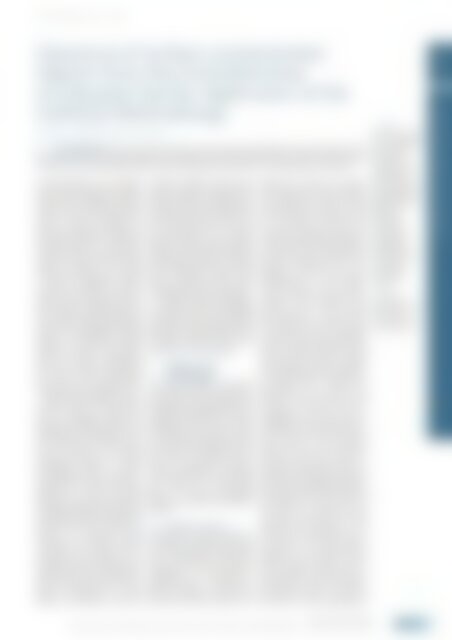Erfolgreiche ePaper selbst erstellen
Machen Sie aus Ihren PDF Publikationen ein blätterbares Flipbook mit unserer einzigartigen Google optimierten e-Paper Software.
<strong>atw</strong> Vol. 63 (<strong>2018</strong>) | Issue 1 ı January<br />
Clearance of Surface-contaminated<br />
Objects from the Controlled Area<br />
of a Nuclear Facility: Application of the<br />
SUDOQU Methodology<br />
F. Russo, C. Mommaert and T. van Dillen<br />
1 Introduction During and after the Fukushima nuclear accident, the possibility existed that surface-contaminated<br />
consumer goods, freight containers and conveyances would be imported from Japan, which revealed the need<br />
for proper criteria and screening levels for surface contamination of these items, to insure protection of the public.<br />
In this framework, it was concluded<br />
that the then existing dose-calculation<br />
models mostly addressed exposure<br />
scenarios for occupationally exposed<br />
workers, which were generally not<br />
aimed at properly evaluating the<br />
effective dose incurred by members of<br />
the public exposed to surface-contaminated<br />
objects. The main difference<br />
between occupational and public<br />
exposure scenarios is that, while<br />
workers may frequently be exposed<br />
to freshly contaminated objects,<br />
members of the public are likely to<br />
come in contact with only one (same)<br />
object during a prolonged period of<br />
time. Therefore, while the hypothesis<br />
of a constant contamination level may<br />
suffice for occupationally exposed<br />
workers, it is less realistic for objects<br />
handled by members of the public,<br />
where the initial contamination<br />
present on the object will be affected<br />
by several removal mechanisms,<br />
which need to be considered when<br />
evaluating the annual effective dose.<br />
Based on these findings, the Dutch<br />
National Institute for Public Health<br />
and the Environment (RIVM) developed<br />
the SUDOQU (SUrface DOse<br />
QUantification) methodology [1] for<br />
the evaluation of the annual effective<br />
dose for members of the public<br />
resulting from exposure to surfacecontaminated<br />
objects. It assumes<br />
time-dependent surface- and air- contamination<br />
levels, whose evolution is<br />
governed by a system of coupled<br />
differential equations, describing the<br />
mass balance imposed by the involved<br />
mechanisms. The surface-activity concentration<br />
(Bq/cm 2 ) is considered to<br />
decrease by radioactive decay,<br />
resuspension and wipe-off (transfer<br />
of activity to the hands). The resuspended<br />
activity contributes to the<br />
(increase in) air-activity concentration<br />
(Bq/m 3 ) and can, in turn, partly re-deposit<br />
onto the object surface. The air<br />
activity concentration is further<br />
affected by radioactive decay and<br />
ventilation. Different exposure pathways<br />
are considered: external-gammaradiation<br />
exposure, inhalation, indirect<br />
ingestion and skin contamination<br />
through wipe-off. The effective dose<br />
can then be calculated as the sum of<br />
the contributions of the exposure<br />
pathways. Based on these intrinsic<br />
properties, the SUDOQU methodology<br />
is particularly attractive for clearance<br />
and exemption calculations, especially<br />
when considering public reuse<br />
scenarios, because they often involve<br />
the prolonged use of the same object.<br />
Therefore, in 2016, a collaboration<br />
was started between Bel V and RIVM,<br />
to extend the scope of the SUDOQU<br />
model, and to test its suitability for the<br />
derivation of surface-clearance levels<br />
for objects released from the controlled<br />
area of a nuclear facility.<br />
2 Objectives and<br />
methodology<br />
The results presented in this paper<br />
were obtained in the framework of a<br />
pilot project, having as main objective<br />
to investigate the applicability of the<br />
SUDOQU methodology for clearance<br />
calculations, and to gain a better<br />
understanding of the interplay among<br />
the involved mechanisms and how<br />
this affects the resulting total effective<br />
dose. This was achieved by performing<br />
deterministic calculations<br />
of the annual effective dose resulting<br />
from exposure to a typical office<br />
item, i.e. a bookcase, considering<br />
different scenarios of use and different<br />
nuclides.<br />
2.1 Reference scenario<br />
In the reference scenario (scenario 1),<br />
a bookcase is considered that leaves<br />
the controlled area of a nuclear facility<br />
with a homogeneous surface contamination<br />
of 1 Bq/cm 2 (different<br />
radionuclides are considered, as<br />
explained further in this Section).<br />
Next, the bookcase is placed in an<br />
office with a 50-m 2 area and a 2.5-m<br />
height and is used by an “average”<br />
office worker, who will be exposed to<br />
the contaminated surface. During<br />
working hours (i.e. 8 h/d, 5 d/w, and<br />
52 w/y, resulting in 2080 h/y, thus<br />
in a duty factor f exp =0.24 [1]) the<br />
worker is in the office at a distance of<br />
3 m from the contaminated bookcase,<br />
by which he incurs a certain exposure<br />
by external (gamma) radiation. The<br />
bookcase is assumed to be contaminated<br />
only on its front panel,<br />
characterised by a 6-m 2 surface.<br />
For the calculation of the externalradiation<br />
dose contribution, the<br />
conversion factor from ambient<br />
dose equivalent to effective dose<br />
(E/H*(10)) is set equal to one, which<br />
is conservative for any irradiation<br />
geometry in the photon energy range<br />
of the considered nuclides. During<br />
office hours, the worker is assumed<br />
to occasionally touch the bookcase,<br />
thereby wiping off some activity from<br />
its surface, with a frequency of<br />
approximately once every three<br />
hours (ϕ = 0.31 h -1 during use) and<br />
an efficiency of 20% (f oth = 0.2, corresponding<br />
to the ratio of the contamination<br />
level of the hands after a<br />
wipe-off event and that of the bookcase).<br />
Activity is also transferred<br />
indirectly to the face after contact<br />
with the hands. This transfer is<br />
modelled by an efficiency of f htf =0.2<br />
(ratio of contamination levels of face<br />
and hands). The individual will thus<br />
incur a skin equivalent dose following<br />
contamination of the skin area of<br />
the hands (A hands =400 cm 2 ) and<br />
of the face (A face =100 cm 2 ), which<br />
eventually also contributes to the<br />
effective dose. Furthermore, part of<br />
the activity on the hands will be<br />
transferred to the mouth (indirect<br />
ingestion): this is assumed to occur<br />
with a frequency equal to that of<br />
wipe-off (0.31 h -1 ). The activity transferred<br />
from the hands to the mouth<br />
per ingestion event is set equal to<br />
100 % (f htm =1) of the activity present<br />
<strong>atw</strong>-Special „Eurosafe<br />
2017“. In cooperation<br />
with the EUROSAFE<br />
2017 partners,<br />
Bel V (Belgium),<br />
CSN (Spain), CV REZ<br />
(Czech Republic),<br />
MTA EK (Hungary),<br />
GRS (Germany), ANVS<br />
(The Netherlands),<br />
INRNE BAS (Bulgaria),<br />
IRSN (France),<br />
NRA (Japan),<br />
JSI (Slovenia),<br />
LEI (Lithuania),<br />
PSI (Switzerland),<br />
SSM (Sweden),<br />
SEC NRS (Russia),<br />
SSTC NRS (Ukraine),<br />
VTT (Finland),<br />
VUJE (Slovakia),<br />
Wood (United<br />
Kingdom).<br />
Revised version<br />
of a paper presented<br />
at the Eurosafe,<br />
Paris, France, 6 and<br />
7 November 2017.<br />
29<br />
OPERATION AND NEW BUILD<br />
Operation and New Build<br />
Clearance of Surface-contaminated Objects from the Controlled Area of a Nuclear Facility: Application of the SUDOQU Methodology ı F. Russo, C. Mommaert and T. van Dillen

















